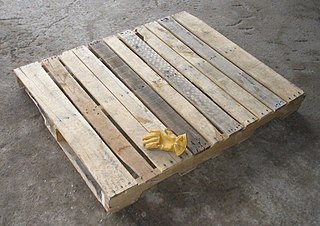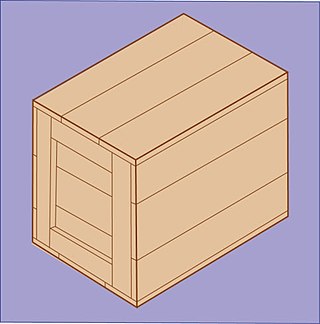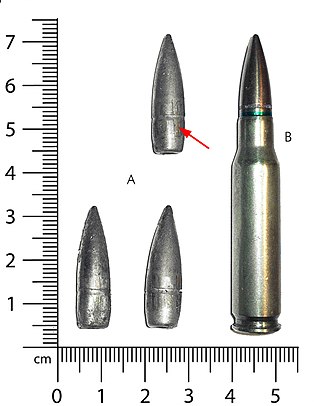
The 5.56×45mm NATO is a rimless bottlenecked intermediate cartridge family developed in the late 1970s in Belgium by FN Herstal. It consists of the SS109, L110, and SS111 cartridges. On 28 October 1980, under STANAG 4172, it was standardized as the second standard service rifle cartridge for NATO forces as well as many non-NATO countries. Though they are not entirely identical, the 5.56×45mm NATO cartridge family was derived from and is dimensionally similar to the .223 Remington cartridge designed by Remington Arms in the early 1960s.

Corrugated fiberboard, corrugated cardboard, or corrugated is a type of packaging material consisting of a fluted corrugated sheet and one or two flat linerboards. It is made on "flute lamination machines" or "corrugators" and is used for making corrugated boxes. The corrugated medium sheet and the linerboard(s) are made of kraft containerboard, a paperboard material usually over 0.25 millimetres (0.01 in) thick.

A box is a container with rigid sides used for the storage or transportation of its contents. Most boxes have flat, parallel, rectangular sides. Boxes can be very small or very large and can be used for a variety of purposes, from functional to decorative.

Packaging is the science, art and technology of enclosing or protecting products for distribution, storage, sale, and use. Packaging also refers to the process of designing, evaluating, and producing packages. Packaging can be described as a coordinated system of preparing goods for transport, warehousing, logistics, sale, and end use. Packaging contains, protects, preserves, transports, informs, and sells. In many countries it is fully integrated into government, business, institutional, industrial, and for personal use.

A pallet is a flat transport structure, which supports goods in a stable fashion while being lifted by a forklift, a pallet jack, a front loader, a jacking device, or an erect crane. Many pallets can handle a load of 1,000 kg (2,200 lb). While most pallets are wooden, pallets can also be made of plastic, metal, paper, and recycled materials.

A crate is a large shipping container, often made of wood, typically used to transport or store large, heavy items. Steel and aluminium crates are also used. Specialized crates were designed for specific products, and were often made to be reusable, such as the "bottle crates" for milk and soft drinks.

Cardboard boxes are industrially prefabricated boxes, primarily used for packaging goods and materials. Specialists in industry seldom use the term cardboard because it does not denote a specific material. The term cardboard may refer to a variety of heavy paper-like materials, including card stock, corrugated fiberboard, and paperboard. Cardboard boxes can be readily recycled.

A tea chest is a type of wooden case originally produced and used to ship tea to the United Kingdom, Australia, Canada, and New Zealand. The conventional tea chest is a case with riveted metal edges, of approximate size 500 by 500 by 750 millimetres.

A bulk box, also known as a bulk bin, skid box, pallet box, bin box, gaylord, or octabin, is a pallet-size box used for storage and shipping of bulk or packaged goods. Bulk boxes can be designed to hold many different types of items such as plastic pellets, watermelons, electronic components, and even liquids; some bulk boxes are stackable.

A wooden box is a container made of wood for storage or as a shipping container.

Electrical or fiber-optic connectors used by U.S. Department of Defense were originally developed in the 1930s for severe aeronautical and tactical service applications, and the Type "AN" (Army-Navy) series set the standard for modern military circular connectors. These connectors, and their evolutionary derivatives, are often called Military Standard, "MIL-STD", or (informally) "MIL-SPEC" or sometimes "MS" connectors. They are now used in aerospace, industrial, marine, and even automotive commercial applications.

Ammunition is the material fired, scattered, dropped, or detonated from any weapon or weapon system. Ammunition is both expendable weapons and the component parts of other weapons that create the effect on a target.
A shipping container is a container with strength suitable to withstand shipment, storage, and handling. Shipping containers range from large reusable steel boxes used for intermodal shipments to the ubiquitous corrugated boxes. In the context of international shipping trade, "container" or "shipping container" is virtually synonymous with "intermodal freight container", a container designed to be moved from one mode of transport to another without unloading and reloading.

The 7.62×51mm NATO is a rimless, straight walled, bottlenecked rifle cartridge. It is a standard for small arms among NATO countries.

Air travel with firearms and ammunition involves a number of laws, regulations and practices that travelers with firearms or ammunition must comply with and should be familiar with before travel. The main rules are set by the International Air Transport Association (IATA), but there are a number of local variations between airlines and local laws that sometimes are conflicting.
The MIL-STD-1168 is a set of standard codes used to identify munitions. It was designed to replace the previous confusing Ammunition Identification Code (AIC) system used by the United States Army Ordnance Department.

A container is any receptacle or enclosure for holding a product used in storage, packaging, and transportation, including shipping. Things kept inside of a container are protected on several sides by being inside of its structure. The term is most frequently applied to devices made from materials that are durable and are often partly or completely rigid.
Reusable packaging is manufactured of durable materials and is specifically designed for multiple trips and extended life. A reusable package or container is "designed for reuse without impairment of its protective function." The term returnable is sometimes used interchangeably but it can also include returning packages or components for other than reuse: recycling, disposal, incineration, etc. Typically, the materials used to make returnable packaging include steel, wood, polypropylene sheets or other plastic materials.





















